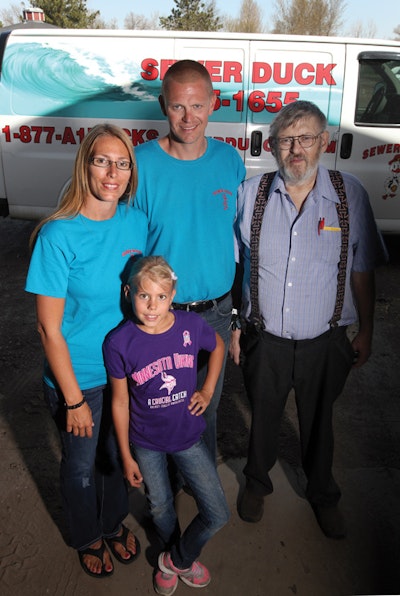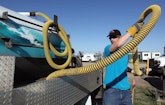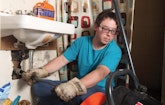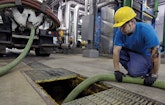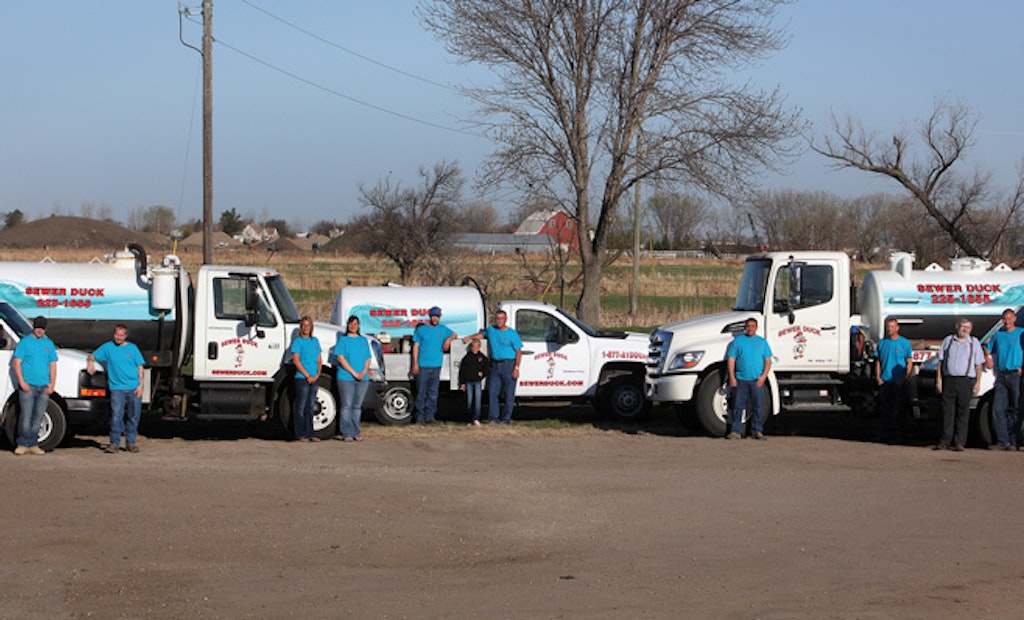Interested in Trucks?
Get Trucks articles, news and videos right in your inbox! Sign up now.
Trucks + Get AlertsWhen Jeff Goldade was about 11 years old, he would reluctantly help out his father, Lyle, who owned Sewer Duck Inc., a drain-cleaning business in Aberdeen, S.D.
“I did what I could to get out of it,” Goldade admits. “But my dad was a single parent, and the only way for him to keep an eye on me was to take me along on jobs. So I’ve been cleaning drains since I was a little pup.”
What a difference 25 years can make. Today, Goldade, 36, is the enthusiastic owner of Sewer Duck, which he bought from his father in 1996 when he was just 19 years old. (“I have no idea how he came up with the name, but I’d never change it,” he says.) He employs five full-time technicians and four part-timers, owns about $300,000 worth of vehicles and equipment and runs a fully diversified business, focused on drain cleaning, portable-restroom rentals/service and septic-tank pumping.
Moreover, by staying abreast of new technology, emphasizing professionalism and customer service, and developing some solid business chops – courtesy of the school of hard knocks – his company now generates about 900 percent more in annual gross income than his first year in business.
“Things changed the older I got – I developed a different outlook,” Goldade recalls, explaining how his attitude toward drain-cleaning work changed. “I had to think about having a future. I wanted to be successful. I grew up with very little … I didn’t want to be poor and not send my kid to college. Since college and the military wasn’t for me, I saw this as a way to be in charge of my own destiny.”
Diversification keys growth
Diversification keyed Sewer Duck’s growth. The company’s business volume is split just about evenly between restrooms, drain cleaning and septic pumping, and their seasonal cycles dovetail well, which helps keep cash flow more consistent year-round. Septic pumping dominates spring and fall, restroom rentals contribute revenue primarily in summer and drain-cleaning work remains steady all year, although winters can be problematic at times, he notes.
Offering multiple services offers other benefits, too; it gives Goldade greater control over time spent on jobs, enhances customer service and promotes repeat business and word-of-mouth referrals. “We can give every customer multiple options,” Goldade explains. “I didn’t want to be that guy who only pumps out septic tanks, then has to call someone else in and wait whenever a drainfield line plugs up.”
Sewer Duck entered the portable-restroom business because only one competitor existed. Goldade bought three restrooms in 1998, then “three turned into six and six turned into nine,” as he puts it. “Then I started ordering 10 and 12 at a time, mostly for construction jobs.”
Thorough job training ensures that all employees can cross over into different roles as required by demand. For instance, during most of 2010, Sewer Duck supplied almost 100 restrooms for a year-long oil pipeline project, almost one restroom every mile for 100 miles. With twice-a-week cleanings, that effectively kept one employee dedicated to just that route for the duration of the project.
“At the time, we had a slide-in unit with a 250-gallon waste and a 150-gallon freshwater tank, and it would take our guy two or three days to work the entire route, then he’d start over again,” Goldade says. That required techs from the septic side of the business to pitch in on the other regular restroom routes.
Large array of equipment
Providing multiple services requires an array of equipment. Sewer Duck owns a 2011 Hino 268A truck with a 1,200-gallon steel tank, built by Satellite Industries and equipped with a pump made by Masport Inc. and a 65-gallon freshwater tank. It’s used for industrial jobs, such as cleaning carwash pits and grain elevators.
To carry drain-cleaning equipment, technicians drive a 2008 Chevrolet Express cargo van and a 2013 Chevrolet Express cargo van.
“I didn’t want to pull up to jobs in a crummy-looking conversion van or a panel van with three on the tree,” he says. “And I lettered them up so they look nice.”
The company also relies on drain-cleaning equipment made by General Pipe Cleaners (a division of General Wire Spring Co.): two JM-1450 portable water jetters (1,500 psi at 1.7 gpm), a Maxi-Rooter, a Speedrooter 91, four Mini-Rooters for smaller drains and three hand-held Power-Vees. The company also owns a RIDGID K-7500 drain cleaner and a RIDGID SeeSnake and pipeline locator.
Goldade calls the SeeSnake “a game changer – worth its weight in gold.” At first, it was a great training tool that helped him see clogs and understand what happens and why. Equally as important, it also provides visual proof of a problem for skeptical customers. And it enables his crews to be absolutely certain a drainline is completely cleaned.
“It’s hard to guarantee your work if you can’t see that you fixed the problem,” he says. “Eliminating the guesswork enabled us to provide a whole other level of customer service. How do you put a price on that? Plus we can charge an additional flat rate for it on top of the regular cleaning flat rate.”
Smaller trucks do the trick
To clean portable restrooms, the company relies on a 2006 International with a 1,250-gallon wastewater/250-gallon freshwater steel tank, made by Imperial Industries Inc. and equipped with a Masport pump; and a 2012 Chevrolet 1-ton pickup truck with a 650-gallon wastewater/250-gallon freshwater chassis-mounted steel tank made by Satellite Industries. Sewer Duck also owns 140 portable restrooms made by Satellite, including five handicapped-accessible units and six VIP units with solar lights and handwash stations, plus three freestanding Satellite handwash units.
Goldade says he prefers small tanks and trucks, even though the mostly rural area that Sewer Duck services is spread out geographically. That’s because he’s able to apply septic waste on land he owns as well as acreage owned by local farmers, and the Aberdeen municipal waste-treatment plant is only a mile from the company’s shop.
“It’s all very convenient,” he notes. “Plus, if my trucks exceed 26,000 pounds, my drivers need a commercial driver’s license [CDL]. Then it’s harder to find guys capable of driving them, plus you need a bigger garage or shop to store the larger trucks. And I want to have my guys able to do any job at any given time. What if I have just one guy with a CDL and he calls in sick, and the only guy available to fill in doesn’t have one? Then I’m stuck.”
On the drain-cleaning end of the business, Goldade says business is split about evenly between residential and commercial/industrial work. The latter includes everything from apartment buildings to plants to a local hospital. Sewer Duck also has a regular gig cleaning a 500-foot-long stretch of main sewer pipe at a local industrial plant.
“The company runs a machine that extrudes cotton fibers,” Goldade explains. “If the line isn’t cleaned regularly, it plugs, and if they have to shut the machine down, it costs them a lot of money. So regular maintenance pays off for them.”
Growing pains forced changes
Growth is great, but it’s not the end-all, especially if it occurs too fast. Goldade found that out the hard way when the company won a bid to become a contract operator for a sanitary district outside Aberdeen.
One thing led to another, and within a span of about 12 years, Goldade found himself with 15 or 16 employees, and handling maintenance operations for about a half dozen districts, mostly located around lakes. Within those districts, Sewer Duck was responsible for maintaining more than 700 lift stations located in the various districts’ independent sewer and water systems, which empty into sewage lagoons.
“At one point, I realized the business had grown too big for me,” he says. “There was a lot more liability and responsibility and more politics than I was willing to deal with. So we downsized.
“These days, my paycheck is the same as it was back then, but I sleep a lot better,” he continues. “Sometimes less is more, you know? At the time, I thought getting bigger would be better. Sure, we made extra money, but most of it went to paying more wages. Now I have less than half as many employees … and my wife, Sara, and I and our child can spend time in Florida during winters. I do everything on my terms and life is good.”
Not that growth is entirely out of the question, as long as it’s slow and manageable, Goldade emphasizes.
“When the company grew in leaps and bounds, I couldn’t keep up with growing pains,” he says. “It was a wild ride. But if we can take what we’re doing right now and maintain it for the rest of the time, I’d be OK with that.
“But I don’t think we want to stop growing completely,” he concludes. “I always want to be the best – provide the best technology, the best service, the best equipment and the best employees. And to do all that, you can’t ever stop working on it. There’s always room for improvement. I don’t want to ever lower my expectations.”
